How To Clean Sludge From Gas Tank
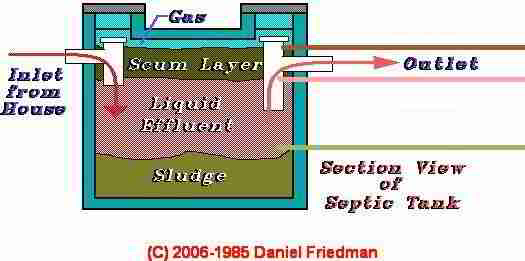 Septic Tank Sewage Levels & What They Mean
Septic Tank Sewage Levels & What They Mean
- POST a QUESTION or COMMENT about the proper, normal, and abnormal level or height of wastewater found in the septic tank
InspectAPedia tolerates no conflicts of interest. We have no relationship with advertisers, products, or services discussed at this website.
Septic tank sewage levels:
Normal & abnormal: this document explains the significance of sewage levels inside of the septic tank and what the overall sewage level indicates about the presence of leaks into or out of the septic tank.
We also explain how the thickness of the floating scum layer and bottom sludge layer give information about the necessary frequency of pumping or cleaning out the septic tank. Finally, we describe septic tank leak repair procedures. We discuss:
We also provide an ARTICLE INDEX for this topic, or you can try the page top or bottom SEARCH BOX as a quick way to find information you need.
The Significance of Sewage Height or Level in Septic Tanks
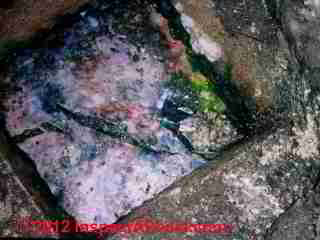 Article contents
Article contents
- What does the height of sewage inside the septic tank tell about its condition
- What do the thickness of scum and sludge levels mean in a septic tank?
- Evidence of leaking septic tanks - leaks out of the tank vs. leaks into the septic tank and what they mean
- When and how to repair septic tank leaks & Inspection specifics for septic tank baffles, septic tank sludge and scum levels or thickness
A normally operating septic tank that is in use is always full of sewage: a mixture of solids, floating scum, and septic effluent. Our photo (left) shows septic dye (green) trying to enter the septic tank at the baffle.
Solids entering a septic tank are intended to remain there until pumped out during tank service. A large portion of solids settle to the bottom of the tank as sludge.
Grease and floating scum remain at the top of the sewage in the tank. Baffles (discussed above) help keep solids, scum, and grease in the tank. Bacterial action in the tank make a modest reduction in the solids volume and begin the processing of sewage pathogens, a step later completed by soil bacteria in the absorption fields.
Liquid septic effluent is what flows out of the septic tank and into the drainfield for final treatment and disposal.
A separate document,
MEASURE SCUM & SLUDGE,
discusses how and why to measure septic tank scum and sludge
Normal septic tank sewage levels: If the liquid and waste level combined was near the top of the tank, that is, level with the bottom of the septic tank outlet pipe, then the tank is operating normally.
High and low sewage levels and thick or thin sewage scum and sludge layer thickness are explained and diagnosed below.
At Septic TANK INSPECTION PROCEDURE we explain that when the septic tank is opened before it has been pumped out or cleaned, important information about the condition of the septic system is available, including the thickness of the floating scum and bottom sludge layers in the tank, the overall sewage level (how high is the sewage level in the septic tank), and other visible signs of problems with the septic tank,
its SEPTIC TANK BAFFLES, piping, or problems with the septic drainfield.
What Does a High Level of Sewage in the Septic Tank Mean?
A high level of sewage in the septic tank is detected by observing that the top surface of the sewage in the septic tank is higher than the bottom of the septic tank outlet pipe. IF sewage is above this point, there is a problem with a blocked or damaged septic tank outlet pipe, a blockage at the distribution box, or a saturated, failing septic drainfield.
Further investigation is appropriate. If the problem is a blocked sewage pipe leaving the septic tank, or a tipped, blocked, or damaged distribution box, repair cost may be modest and the drainfield may have additional remaining life.
Explanation of how to diganose abnormal septic tank sewage levels is found
at SEPTIC TANK BACK FLOODING
Watch out: Any time there is evidence that solid sewage has left the septic tank, say from a lost or damaged tank baffle the result is a reduced septic drainfield life because solids entering the drainfield speed clogging of its piping and its surrounding soil.
See SEPTIC TANK BAFFLES
What Does a Low Level of Sewage in the Septic Tank Mean?
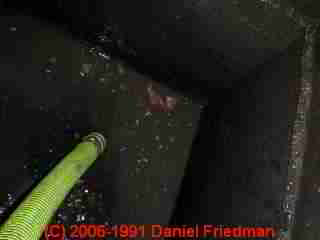 A low level of sewage in the tank is detected by observing, when septic tank is opened, that the top of the floating scum layer is one or more inches below the bottom of the septic tank outlet pipe.
A low level of sewage in the tank is detected by observing, when septic tank is opened, that the top of the floating scum layer is one or more inches below the bottom of the septic tank outlet pipe.
Normally low levels of sewage
in the septic tank may occur by transpiration - movement of moisture out of the tank by evaporation or vapor passage out through leaks in the cover if the septic tank has been un-used for months or longer.
Unusually low levels of sewage
in the septic tank would be defined as sewage top below the tank outlet pipe bottom edge when a septic tank is in active use.
Low levels of sewage in the tank suggest that the septic tank has a leak. Low septic tank levels can have several causes depending on the tank age and the material from which it was built.
- Low Sewage Levels in Concrete septic tanks:
If the tank is made of concrete it should be pumped and cleaned thoroughly so that your contractor can inspect the tank for cracks or other damage.
- Low Sewage Levels in Plastic/Fiberglass septic tanks:
after pumping the tank, look for a lost drain plug in the tank bottom. Even pumping the tank can accidentally remove this plug - a condition you won't notice until the next time it's pumped.
- Low Sewage Levels in Steel Septic Tanks:
Pump the tank completely, clean and inspect for rust holes - it's common for the bottom of such tanks to rust completely away.
- Low Sewage Levels in Home Made or Site Built Septic Tanks:
Watch out: there is risk of tank collapse or leaks when septic tanks are site-built such as using concrete blocks or stone. Leaks are likely
Check for Leaks Out of or Into the Septic Tank
Leaks out of the septic tank: As we explained above, a low level of sewage in a septic tank that has been in active use means there is a tank leak out. In a home occupied by a family of four people, an empty 1000 gallon septic tank (having just been pumped) would be expected to be full of liquid waste and sewage again in about a week or even less.
After the septic tank has been pumped out it may be useful to inspect its interior for evidence of cracks, settlement, or damage to its baffles, or perhaps to confirm the tank size if most of the tank has remained buried.
If a septic tank has been serviced by removing a cover over the entire tank all of these conditions can be seen easily. But more often the tank is pumped by access through a center cleanout port.
If there is no center cleanout port on a septic tank (some older concrete tanks) it is pumped preferably at the outlet end of the tank but possibly at the inlet end. Septic pumpers may use a tool such as the one shown here, [photo] a combination of a mirror at the end of a pole and a flashlight to look at the tank interior.
Look for Evidence of damage to the tank itself such as cracks, leaks, or additional evidence of damaged tank baffles.
Look for leaks into the septic tank:
At SEPTIC TANK LEAKS we explain how and why leaks into a septic tank cause septic system failures. But if a septic tank and the drainfield are working, a leak into the septic tank will not produce abnormally high levels of sewage in the septic tank - since excess groundwater running into the septic tank will continue onwards to the drainfield.
Repairing Septic Tank Leaks
If you have not already reviewed SEPTIC TANK SAFETY please do so before continuing in this section. There are serious risks of injury, explosion, and death if safe procedures are not followed when working on septic systems.
Steel septic tanks that are leaky are usually doing so because the bottom of the tank has rusted through, or the tank may have rusted through at the sides, especially near the baffles, or at a point of mechanical damage. A rusted steel septic tank needs to be replaced.
Concrete septic tanks that are leaky can often be repaired.
The septic tank is pumped clean, washed out, the washing water is also pumped out, and a trained professional, wearing an air supply tank, breathing apparatus, and protective clothing, enters the tank to inspect and repair cracks or holes using concrete patching material or special caulks.
The repair person is monitored by at least one other expert who is similarly equipped but who remains outside the tank.
Septic Tank Safety Warnings - Never Enter the Septic Tank - it can be fatal
- Don't work alone: Falling into a septic tank or even leaning over a septic tank can be fatal. Do not work on or at septic tanks alone - workers can become suddenly overcome by methane gas.
- Watch out: Do not ever go into a septic tank to inspect or repair it unless you are specially trained and are wearing the special equipment and gear for that purpose, including self-contained breathing apparatus.
- Don't enter the septic tank to rescue someone: Never go into a septic tank to retrieve someone who has fallen in and was overcome by toxic gases without a self-contained breathing apparatus (SCBA). if a SCBA is not available, call for emergency services and put a fan at the top of the tank to blow in fresh air.
- Don't even lean over the septic tank openings: Do not lean over or stick your head into the septic tank to examine its interior - you could fall in to the tank or become overcome by gases and fall into the tank, an event which is likely to be fatal.
- Don't ignite flames near the septic tank: Do not light a flame at or near the tank - methane gas is explosive. At one tank pumpout my client described the explosion and burns received by the pumping contractor when he stood by the tank and lit a cigarette. Another exploded their septic tank by burning brush that was piled over the tank.
- Work area around the septic tank must be ventilated: Decomposing wastes in the septic tank produce toxic gases (such as methane) which can kill a human in a matter of minutes. When working on a tank be sure the area is well ventilated.
- Rope off Dangerous Septic Tanks, Cesspools, Drywells, Work Sites: If your inspection discover that there are dangerous conditions, such as an unsafe tank cover, tank collapse, or a home-made septic tank or cesspool (which are at increased risk of sudden collapse) such areas should be roped off and clearly marked as dangerous to prevent access until proper evaluation and repairs can be made.
- See SEPTIC TANK SAFETY for more about septic tank dangers and hazards and safe inspection or service and repair procedures.
What Does a Thick Layer of Floating Scum or Bottom Sludge in the Septic Tank Mean?
Scum layer thickness: If the floating scum layer and or the septic tank bottom sludge layer are thick, then the septic tank needed to be cleaned or pumped out. Just how thick is "thick"? As we discuss in more detail
at MEASURE SCUM & SLUDGE, the septic tank needs to be pumped when the floating scum layer has accumulated to reach 3 inches of the bottom of the outlet baffle or tee.
Sludge layer thickness: As we discuss in more detail
at MEASURE SCUM & SLUDGE, normally a septic tank should be pumped when the bottom layer of sludge is within 18 inches of the tank outlet.
Septic effluent retention time:
As we explain
at EFFLUENT RETENTION TIME,
it would be better for the life of the drainfield to pump the septic tank sooner than this, depending on the septic tank size, depth, and general shape.
That's because a small net-free area, the space between the bottom of floating scum and top of bottom sludge, means that the septic tank will have a reduced net retention time, or reduced settling time - so we are more likely to push floating solids out into the drainfield where its life is then reduced by that debris.
What Does a Thin Layer of Floating Scum or Bottom Sludge in the Septic Tank Mean?
If the liquid and waste level combined was near the top of the tank - normal, as stated just above, but the thickness of the floating scum layer or thickness of the sludge layer on the bottom of the tank or both were thin - that is, if there was not much solid waste in the tank but the combined solid and liquid level was normal, then the tank was operating very well and/or in only light use, and you can safely wait a bit longer than the recommended septic tank pumping frequency in our tank pumping table.
What are the "Normal" or "Correct" Sewage Levels in a Septic Tank?
Reader Question: I saw stuff floating about 4" from the top of my septic tank and concluded the septic tank needed pumping. Is that normal?
 I have a 1200 gallon tank that was installed new 6 years ago. It is taking care of a rented duplex unit (2 family) I recently had it pumped out. When I looked into the tank I saw water and other things floating within approximately 4 inches from the top.
I have a 1200 gallon tank that was installed new 6 years ago. It is taking care of a rented duplex unit (2 family) I recently had it pumped out. When I looked into the tank I saw water and other things floating within approximately 4 inches from the top.
When I commented to the tank truck guy that it looks as though the tank was full and needed pumping out he said yes. When I mentioned to someone else that the tank was full I was told that the tank is always operating with the water up to within inches of the top of the tank.
So I ask you if I remove the cover from the septic tank at anytime will the water level always be that high? Thank you in advance Bill - William Rebman
Reply: a properly operating in-use septic tank will always be full to just the height of the bottom of the outlet effluent pipe. Higher or lower levels indicate a problem.
Bill,
Remember that a normally operating septic tank is always full, right up to the level of the exit pipe that drains off effluent to the drainfield or soakaway bed.
So yes, if you open a septic tank at any time the wastewater will be high - roughly up to the outlet pipe.
Definition of a "normally full" septic tank
Let's refine this "septic tank full level" definition just a little bit.
When you open a working septic tank, what you see as the very top level of the wastewater in the septic tank is the upper surface of the floating scum layer - the brown line in our sketch at above left. You cannot really see the top of the effluent in the septic tank except for a brief period after the septic tank has been pumped clean and refilled with wastewater - before the new floating scum layer has formed.
Floating scum layer top - brown line in sketch: The upper surface of the floating scum area in a working septic tank will be somewhere between the height of the bottom of the outlet pipe and the top of the inlet and outlet pipe baffles or tees - depending on the thickness of the scum layer.
When a septic tank has been in use and not pumped for some time, the increased thickness of the floating scum layer may cause the absolute top of all the waste material in the septic tank to be above the wastewater exit pipe, as you can see by the brown line in our sketch. That is not necessarily an indicator of a problem.
Remember that you are looking down onto the septic tank contents from the top, not from the side as shown in our sketch.
This higher level of the floating scum layer is OK provided that the septic tank baffle or tee is intact or in place to keep the floating solids from flowing out of the septic tank (where they would clog the drainfield).
Our septic system sketch (above left) shows these protective "septic tank tees" as white pipes at the inlet and outlet ends of the septic tank.
Actually, in a healthy septic tank working normally, the septic effluent will be up inside the tee or behind the tank baffle up to a level just even with the bottom of the septic tank outlet pipe.
More about septic tank baffles and tees and their inspection, repair or replacement is
at SEPTIC TANK BAFFLES.
Liquid effluent level top - pink line in sketch:
When you open and look into a normally operating septic tank the effluent level - the liquid waste level - in the septic tank will be just below the bottom of the septic tank effluent outlet pipe - the pink line in our septic tank sketch above.
As we explained above, if there is a floating scum layer it will be atop the liquid effluent in the septic tank - so you may not see the liquid effluent itself.
But provided that the septic tank baffles and tees are intact and in place, it is the location of the top of the effluent layer that tells us if the septic tank and drainfield are in trouble or not - as we elaborate just below.
Depending on the thickness of the floating scum layer, the effluent level will be either exactly at the bottom of the outlet pipe, or it may be pushed down by the floating scum layer to be ever slightly below that point. When new wastewater enters the septic tank, that increased liquid water volume will cause the effluent level to rise and liquid effluent will flow out of the septic tank exit pipe.
Definition of "abnormal septic tank sewage levels"
Abnormally high sewage effluent levels in the septic tank are any effluent levels above the outlet pipe - indicating a blockage, clog, or flooded drainfield. Remember we're talking about the effluent, not the floating scum that we discussed just above.
Abnormally low sewage levels are any level of wastewater below the outlet pipe, usually indicating that the tank has a leak.
Exceptions to low levels include, of course, the period right after the septic tank has been pumped. Depending on septic tank size and the level of its usage, number of building occupants, amount of wastewater sent daily into the septic tank, it can take a few days for it to refill after pumping.
Given that the normal height of an effluent wastewater pipe is a foot or more below the very top of the septic tank, wastewater up to 4" from the top of your septic tank may mean that the outlet pipe opening itself was clogged or that there is a blockage or flooding in the septic drainfield - possible signs that a costly repair will be needed soon.
Further, if during the septic tank pumpout you heard wastewater running backwards from the drainfield and through the septic tank exit pipe back into the septic tank that would be a sure indicator that the drainfield is flooded.
"The septic pumper agreed that because the tank was full it needed to be pumped": is therefore not quite correct.
The tank is normally always "full". But remember that many septic pumper truck operators may not have been English majors in school and may not communicate precisely.
Or the septic pumper may have been referring to the formation of a thick floating scum or settled sludge layer, either or which would indeed mean that the septic tank may have been past due for a cleanout.
Either the SEPTIC TANK PUMPING SCHEDULE or a thick scum layer
or thick settled sludge layer (MEASURE SCUM & SLUDGE) indicate when a septic tank should have been pumped.
Reader Question: How far down should the sewage be below the rim of the outside sewage tank?
(May 23, 2015) Susan said:
How far down should the sewage be below the rim of the outside sewage tank?
Reply:
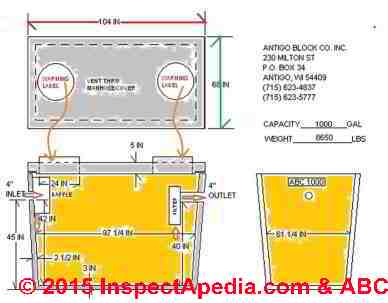 The liquid effluent level, seen through the baffle or tank tee, will be just at the bottom of the septic tank outlet pipe.
The liquid effluent level, seen through the baffle or tank tee, will be just at the bottom of the septic tank outlet pipe.
The floating scum layer may be several inches higher than that and should be blocked by the tank baffle.
If you see sewage that is flowing over the top of the baffle or effluent that is higher than the bottom of the outlet pipe then the outlet piping is blocked or the drainfield has failed.
Typically (septic tank dimensions vary) the very top of the septic tank walls will be 12-18" higher than the bottom of the 4-inch to 6-inch diameter septic tank outlet pipe opening.
Our illustration at left, adapted from a sketch from Antigo Block Company, 230 Milton St, Antigo Wisconsin (a producer of concrete septic tanks Tel: 715-623-4837), shows some example septic tank dimensions.
Septic tanks produced by other manufacturers will vary in total capacity, dimensions, wall thickness and other features but this tank is fairly typical.
[Click to enlarge any image]
Here are some dimensions from Antigo Block's septic tank.
The brown arrows show sewage entering the septic tank at the left end, moving down through the inlet baffle into the septic tank, and at the right side of the tank, clarified effluent (settled sludge and floating scum have separated) moves up through the septic filter and out through the septic tank outlet opening.
- Top view (gray in our sketch) shows the rectangular top of the septic tank as 68" x 104" with manhole covers providing access to the septic tank inlet and outlet ports for cleaning and inspection.
- This tank is produced with 4-inch inlet and outlet pipe openings; other tanks may use a 6-inch opening for waste pipe inlet and drainfield outlet pipe connections.
- The bottom of the septic tank inlet is 45" above the tank bottom and the top of the septic tank inlet is about 6" below the top edge of the septic tank wall.
- The top of the septic tank inlet baffle is an inch or two below the top of the septic tank wall.
The bottom of the 24" tall septic tank baffle extends to 42" above the bottom of the septic tank and thus 3" below the bottom of the septic tank inlet baffle.
- The top of the septic tank outlet baffle, in this tank actually an outlet effluent filter, extends about 2" above the top of the septic tank outlet pipe (at the right of the sketch). The bottom of the septic tank outlet pipe is 40 inches above the bottom of the septic tank.
Note that this is 2-inches lower than the bottom of the septic tank inlet opening.
The septic tank outlet should always be a bit lower than the septic tank inlet, othewise sewage would run backwards into the septic tank inlet pipe and would clog the system. We've seen this happen when a septic tank was installed "backwards".
OK so with these example dimensions, where will the top of the liquid effluent be in this septic tank if the system is working properly and the septic tank is in active use?
It will be 40" above the tank bottom - visible at the outlet tee.
Reader Comments & Q&A
@Paul Harrison
If you think about it the floating scum layer is made up in part of grease and fats, so if you don't have that floating on the top of your septic tank that's perfectly fine. It's not an indication of a problem.
Hi. My scum layer has vanished and I only have water in my tank. I've tried chemicals but I think they are to help break down matter but I cannot produce scum. Any ideas?
@Sumiko, the diagram at the top of this page is a typical septic tank that's getting near ready to be pumped. When this fudge layer and floating scum layer begin to be too thick the net free area is reduced and there's inadequate settling time in the tank
Is the diagram at the top of this article a diagram of a properly functioning tank or improperly functioning tank?
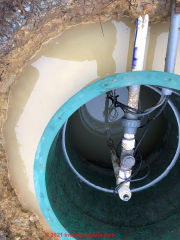 I agree that if your collection tank level is above the outlet into the ATU you then there must be a clog in that location.
I agree that if your collection tank level is above the outlet into the ATU you then there must be a clog in that location.
I thought at first that perhaps the ATU you had also been flooded which caused the collection tank to flood and then subsequently the ATU pump was able to get ahead.
But that wouldn't explain why the collection tank wouldn't drain down to a normal level into the ATU unless salads are floating scum are blocking the outlet.
Regardless we need to find the rest of the surface water leaks into those tanks and fix them.
In addition to ceiling the obvious leak points you need to direct surface runoff away from that area.
Third Photo...dosing tank.[Above]
Second photo... ATU - below

I have a three-tank system that is giving me absolute FITS when we have a rain event (and lately we've had far too many). My system is comprised of the original concrete septic tank (1000 gallon), which discharges into a WhiteWater DF50 Aerobic Treatment Unit, which in turn gravity feeds into another 1000 gallon dosing tank.
Last weekend I thought I had resolved the continuing high water alarms in the dosing tank as I found and fixed three infiltration sites (inlet and outlet of the original septic, now the collection tank), and at a joint in the riser to the dosing tank.
After I had sealed these water intrusion spots, the effluent pump managed to actually pump the level down where the on/off float actually turned the pump off (first time that's happened in all the time I've lived here (7 months). However, we had in excess of an inch of rain today, and when I got home from work, we had another HWA.
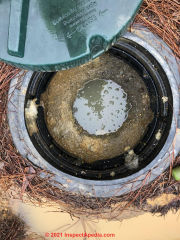 The level in the dosing tank was not overly high (tank about 2/3 full), but the collection tank was COMPLETELY full (up to the rim), and the cone in the ATU had a significantly higher amount of floating solids and smelled worse than it normally does. My concerns, in order:
The level in the dosing tank was not overly high (tank about 2/3 full), but the collection tank was COMPLETELY full (up to the rim), and the cone in the ATU had a significantly higher amount of floating solids and smelled worse than it normally does. My concerns, in order:
1. Why wouldn't the collection tank continue to drain into the ATU, which should lower the level in the tank,
2. Is the ATU becoming overloaded and that's why there is more than normal amount of smell and floating solids?, and
3. What's stopping the ATU from draining into the dosing tank?
It's almost like the excess groundwater is stopping the system from flowing like it should.
he elevation of the drains in the house is about 6" higher than the elevation of the top of the collection tank, but I'm concerned that given we are expecting two more days of rain, I may wind up with sewage in the house...
I've attached three photos, working through the system.
First is the collection tank, showing where the water level is (very high), [Photo just above] second is the ATU cone, showing excessive floating solids, third is the dosing tank. Please provide some pointers!! Thanks
...
Continue reading at EFFLUENT RETENTION TIME or select a topic from the closely-related articles below, or see the complete ARTICLE INDEX.
Or see SEPTIC TANK SEWAGE LEVEL FAQs questions & answers posted originally at this article
Or see these
Septic Pumping Procedure & Pumper Truck Operation Articles
- FILTERS SEPTIC & GREYWATER - how they extend drainfield life
- SEPTIC TANK INSPECTION PROCEDURE
- SEPTIC TANK PUMPING MISTAKES
- SEPTIC TANK PUMPING PROCEDURE
- CLEANING SEPTIC TANKS
- WHEN to CLEAN THE SEPTIC TANK
- WHEN NOT TO PUMP A SEPTIC TANK
- FIND the SEPTIC TANK, HOW TO
- HOW TO OPEN a SEPTIC TANK
- INSPECT the SEPTIC TANK BEFORE PUMPING
- SEPTIC TANK INSPECTION PROCEDURE
- SEPTIC TANK LEVELS of SEWAGE
- EFFLUENT RETENTION TIME - net free area in tank gives time for settling solids to let clarified effluent exit into the drainfield
- MEASURE SCUM & SLUDGE - How does a septic pumping company actually measure the sludge, scum, and effluent thicknesses when we can't see down through all that floating crud?
- HOW TO MEASURE SEPTIC SCUM LAYER
- HOW TO MEASURE SEPTIC SLUDGE LAYER
- SEPTIC TANK BACK FLOODING
- TOOLS for MEASURING SCUM & SLUDGE
- PUMPER TRUCK OPERATION PROCEDURE
- PUMPING the SEPTIC TANK
- RECORD SEPTIC TANK LOCATION
- SEPTIC PUMPING CONCLUSIONS
- SEPTIC TANK PUMPING REASONS
- SEPTIC TANK PUMPING SCHEDULE
- SEPTIC TANK SAFETY
- SEPTIC TANK TEES - alternative to baffles or good for repairs
Suggested citation for this web page
SEPTIC TANK LEVELS of SEWAGE at InspectApedia.com - online encyclopedia of building & environmental inspection, testing, diagnosis, repair, & problem prevention advice.
Or see this
INDEX to RELATED ARTICLES: ARTICLE INDEX to SEPTIC SYSTEMS
Or use the SEARCH BOX found below to Ask a Question or Search InspectApedia
...
Ask a Question or Search InspectApedia
Questions & answers or comments about problems with the operation of aerobic septic systems
Try the search box just below, or if you prefer, post a question or comment in the Comments box below and we will respond promptly.
Search the InspectApedia website
Note: appearance of your Comment below may be delayed: if your comment contains an image, web link, or text that looks to the software as if it might be a web link, your posting will appear after it has been approved by a moderator. Apologies for the delay.
Technical Reviewers & References
Click to Show or Hide Citations & References
Publisher InspectApedia.com - Daniel Friedman
How To Clean Sludge From Gas Tank
Source: https://inspectapedia.com/septic/Septic_Tank_Sewage_Levels.php
Posted by: hatfieldplancionsing.blogspot.com

0 Response to "How To Clean Sludge From Gas Tank"
Post a Comment